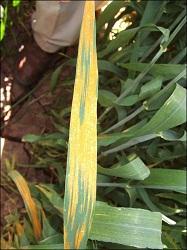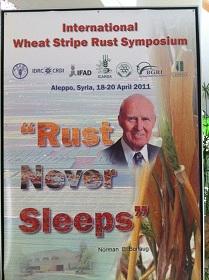The state of smart cities in MENA
11 December 2025
Published online 20 April 2011

Agriculture researchers from across the world are gathered in Aleppo, Syria, to discuss ways to tackle the spread of wheat yellow rust, a fungal disease that threatens to wipe out millions of hectares of the staple food each year.
The International Wheat Stripe Rust Symposium is underway at the International Center for Agricultural Research in the Dry Areas (ICARDA), and will run till 20 April 2011.
A new, particularly virulent strain of Puccinia striiformis, the fungus that causes wheat yellow rust, surfaced in the Middle East in 2010. There are no reported estimates, but Michael Baum, director of the Biodiversity and Integrated Gene Management Program at ICARDA in Syria, reckons the fungus has wiped out between 20 to 50% of Syria's wheat yield in 2010. It has also spread to neighboring Lebanon, Iran, Iraq and Turkey.
The wheat yellow rust fungus continually mutates to overcome wheat resistance and breeders need to develop resistant varieties of wheat to stay one step ahead.
Developed countries are usually more prepared to control wheat rust epidemics. They can quickly roll out fungicides to control an outbreak while resistant wheat varieties are bred and introduced. However, developing world countries sometimes are not ready – that is why the epidemic took Syria by surprised last year.
"Some countries, such as Syria and Iraq, did not have experience in how to handle such an epidemic in the past," says Osman Abdalla, a senior bread wheat breeder at ICARDA. "Others, such as Turkey, were prepared because they have had experience with this before."
It can take approximately 10 years to develop a new variety after the first cross between breeds, explains Baum. "So the cross we make today is not for tomorrow, it is for the product after tomorrow. We have to do a certain degree of anticipatory breeding. You have to know what are the problems in the future."
We must have a formal network with commitment to help the flow of information and material.
No matter how resistant a certain variety is, the fungi will eventually overcome the resistance. "So any good variety after 10 or 20 years will eventually start going down. That is why we have to continuously do breeding and develop new material that are resistant to these diseases," adds Baum.
"Rust is a major threat to wheat production and that is a major staple crop in this region of the world," says Mahmoud Solh, general director of ICARDA. "It is a major source of daily calories so when we talk about reduction of yield we are talking about a major threat to food security."
"Wheat is the basis for political stability and as prices rise, you are going to get a lot of insecurity. It is inevitable," says Ronnie Coffman, director of the Durable Rust Resistance in Wheat Project, a collaborative effort led by Cornell University, New York.
Syria's wheat crop was vulnerable because farmers mainly grew one variety of wheat. One wheat variety, Sham 6, was planted on more than 75% of Syria's wheat farms. The fungal infection rapidly spread throughout the country in 2010. "If you cover more than 25% of the whole area with one variety you are setting yourself up for disaster. You must have multiple varieties in case one of them breaks, and they must be of different genetic backgrounds." says Abdalla.
"As long as wheat is an inbreeding crop, we need to convince the governments to show long-term commitment to research, breeding and pathology because a lot of these problems are homemade and there are a lot of things you can do to evade these problems," says Baum.

A particular strain of stem rust, Ug99, named after it was identified in Uganda in 1999, is a virulent strain that has ravaged Africa over the past few years. It is thought to have destroyed up to half of the wheat crop of Kenya in 2003 and spread to Sudan in 2006 before crossing the Red Sea into Yemen. "We were expecting it in Iran in 2009, but it arrived early in 2007", says Solh.
"Technically, black stem rust is more serious since it attacks the stem of the wheat plant and kills the crop completely. But so far, in this particular area of the world, environmental conditions are not very inductive to Ug99," adds Solh.
The fungus Ug99, which is airborne, is yet to spread widely and infect crops in the Middle East thanks to the prevailing winds blowing away from the region. It also prefers wetter climes so the dry atmosphere of the Middle East offers some protection. However, some researchers are concerned that Ug99 might arrive in the Middle East from Afghanistan. In January 2010, Egypt developed two new strains of wheat resistant to Ug99 and sent them to Afghanistan in an attempt to stop the fungus in its tracks.
Coffman contends that Ug99 will eventually be a problem in the Middle East and urges for the introduction of new varieties of wheat before this happens. The best opportunity to introduce these, says Coffman, will be when new varieties resistant to the new strain of wheat yellow rust become available.
Abdalla is hopeful that the meeting in Syria could produce a consensus on the formation of a regional network of scientists and breeders since wheat yellow doesn't recognize national borders. "We must have a formal network with commitment to help the flow of information and material."
doi:10.1038/nmiddleeast.2011.49
Stay connected: